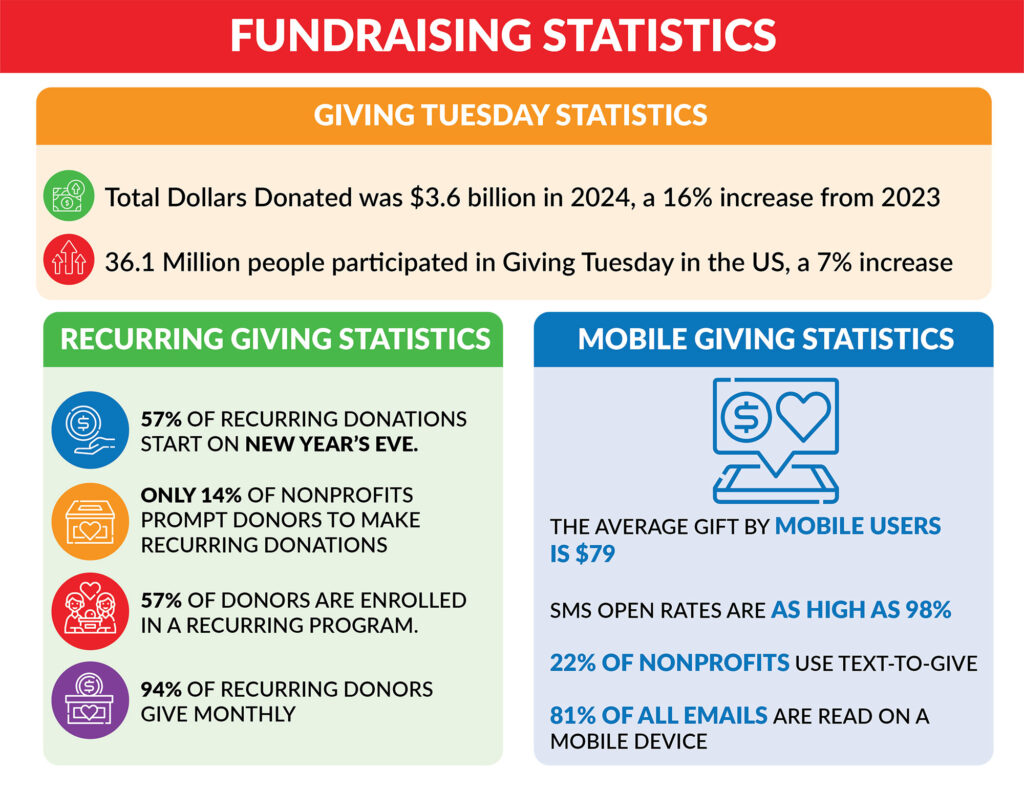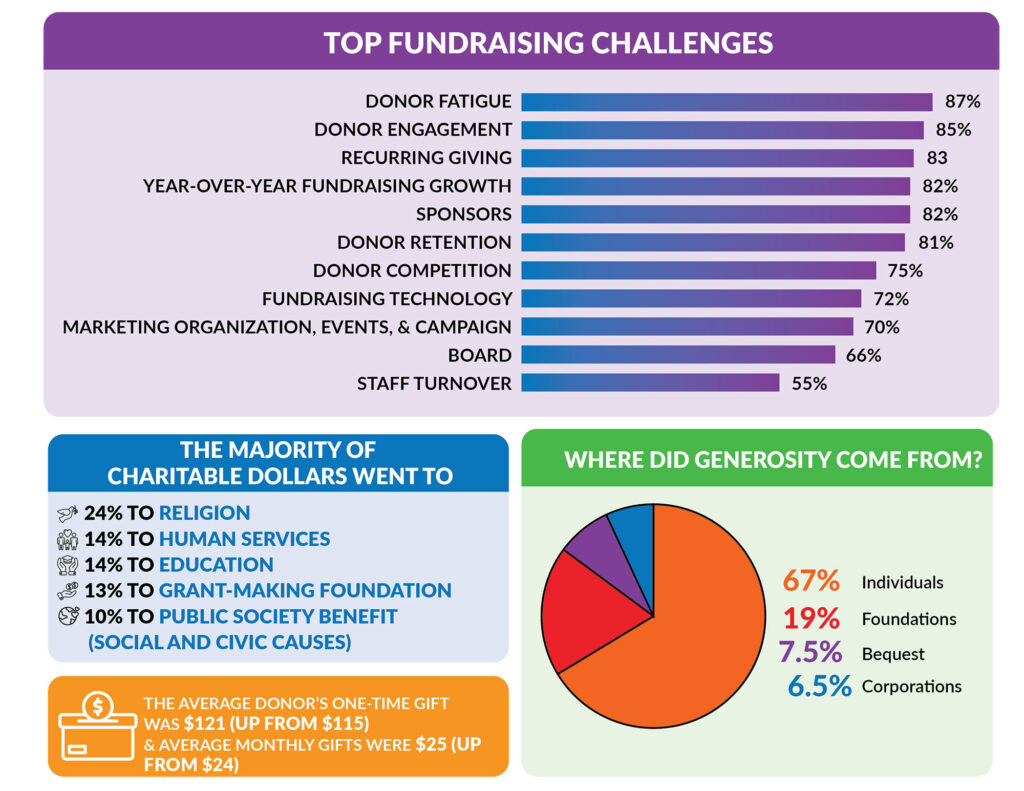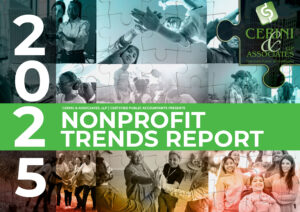Fundraising is more important than ever as nonprofits navigate a challenging landscape marked by inflation, increased competition, and evolving donor expectations.
Community-Centric Fundraising
Building and nurturing a sense of community is becoming increasingly important. Nonprofits are focusing on intimate community events, supporter circles, and local engagement to foster long-term relationships with donors. This approach not only helps in immediate fundraising but also lays the groundwork for sustained support over the years. By creating a strong community, nonprofits can ensure a loyal donor base that feels personally connected to the cause.
Hyper-Personalization
Donors expect personalized experiences similar to what they receive from commercial brands. Using AI and data analytics, nonprofits can create hyper-personalized communication based on donor interests, behaviors, and giving histories. This trend is crucial for building stronger, more meaningful relationships with donors. Personalized messages and targeted campaigns can significantly increase donor engagement and retention.
Digital and Mobile-First Interactions
With younger generations being digital natives, there is a significant shift towards digital-first fundraising strategies. This includes leveraging social media, email, texting, and crowdfunding platforms to engage donors. Traditional methods like phone calls and direct mail are becoming less effective. Nonprofits must adapt to these changes by optimizing their online presence and ensuring that their digital communication is engaging and user-friendly.
AI and Automation
AI is playing a pivotal role in enhancing fundraising efficiency. From AI-powered personalization of donor outreach to using predictive analytics for donor behavior, AI tools are helping nonprofits streamline their processes and improve donor engagement. AI is also being used for grant writing, donor retention strategies, and fraud detection. However, it is essential to balance AI’s efficiency with the need for a human touch in communications to maintain donor connections.
Influencer Fundraising
Collaborating with influencers can amplify a nonprofit’s reach and impact. Influencers, whether they have a large following or a dedicated niche audience, can help spread the word and attract new donors. This trend is expected to grow as more people turn to social media for information and engagement. By partnering with influencers who align with their mission, nonprofits can reach new audiences and build credibility.
Transparency and Impact Reporting
Donors are increasingly interested in seeing the impact of their contributions. Providing detailed impact reports and being transparent about how funds are used can build trust and encourage continued support. This is especially important for engaging younger donors who value transparency and accountability. Clear and honest communication about the use of funds and the outcomes achieved can strengthen donor relationships and boost fundraising efforts.
Peer-to-Peer Fundraising
Peer-to-peer fundraising continues to be a powerful tool. By empowering supporters to fundraise on behalf of the organization, nonprofits can expand their reach and engage new donors. This method leverages the personal networks of existing supporters, making it a cost-effective strategy. Encouraging supporters to share their personal stories and reasons for supporting the cause can inspire others to donate.
Sustainable and Ethical Practices
There is a growing emphasis on sustainability and ethical fundraising practices. Nonprofits are expected to adopt environmentally friendly practices and ensure that their fundraising methods align with their values and mission. Demonstrating a commitment to sustainability can attract donors who prioritize ethical and responsible giving.
Planned Giving
The Great Wealth Transfer is a transformative moment for nonprofits, with between $11 and $12 trillion expected to flow directly to charitable organizations. Planned giving allows nonprofits to build lasting donor legacies by encouraging bequests and other estate gifts. Additionally, with $106 trillion being passed to heirs, nonprofits have a growing opportunity to cultivate relationships with potential major donors, ensuring continued support and impact.
More Nonprofits, Less Giving, and Inflation
Inflation has significantly impacted charitable giving, with 47% of Americans reducing their donations. In 2022, Americans donated the smallest amount in 30 years, representing only the fourth decline in charitable giving in four decades. This decline, coupled with the increasing number of nonprofits (about 100,000 new organizations each year), means more competition for fewer donations. Nonprofits need strategies to do more with less and attract and retain donors despite these challenges.
Machine Learning, Predictive Modeling, and Artificial Intelligence
Advancements in AI are revolutionizing fundraising strategies. Nonprofits use machine learning and predictive modeling to automate donor segmentation and optimize outreach. AI helps answer critical fundraising questions, such as who to contact, how to contact them, and what messaging to use. However, nonprofits should balance AI’s efficiency with the need for human touch in communications to maintain donor connections.
Automation in Fundraising
Emerging technology tools are increasing automation in nonprofits, freeing up staff for mission-based work. Automation tools can handle online donations, donor management, email marketing, event management, and more. While automation improves efficiency, it’s essential to have human oversight to ensure accuracy and maintain a personal touch.
Social Media: Broader Communication and Deeper Relationships
Social media remains a vital tool for nonprofit fundraising. Engaging with donors on social media can lead to significant actions, such as donations, volunteering, and event participation. Nonprofits should leverage social media to reach a broader audience and deepen relationships with supporters. Regular updates, engaging content, and interactive campaigns can keep donors connected and involved.
Generational Power Shifts
As Baby Boomers retire, Millennials are stepping into leadership roles within nonprofits. To ensure smooth transitions, nonprofits should incorporate generational diversity into their leadership teams now. This approach facilitates continuity and prepares organizations for future leadership changes. Engaging younger leaders can bring fresh perspectives and innovative ideas to the organization.
Investing in Gen Z
Gen Z, the largest generation yet, is passionate about change and social causes. While they may not be ideal donors now, building relationships with Gen Z can pay off in the future. Nonprofits should engage with Gen Z early to be top of mind when they become financially capable of giving. Creating opportunities for Gen Z to get involved, such as through volunteer programs or social media campaigns, can foster long-term loyalty.
The Widening Wealth Gap
Income inequality is affecting nonprofit donor bases, with fewer people having the financial capacity to give. Nonprofits must focus on attracting and retaining top donors to ensure sustainability. Building strong donor relationships is more critical than ever. Personalized communication and demonstrating the impact of donations can help retain high-value donors.
Growing Significance of Transparency and Number-Driven Communications
Transparency in operations and financial management is crucial for building donor trust. Nonprofits should use financial data to demonstrate impact and communicate effectively with donors. Annual reports are an excellent opportunity to showcase the organization’s achievements and encourage continued support. Providing clear and concise financial information can reassure donors that their contributions are being used effectively.
Event Planning for Fundraising Success
In-person events are making a strong comeback, and nonprofits need to capitalize on this trend. The events industry is optimistic, with a Knowland survey indicating up to 10% higher attendance for in-person events in 2024, and research by Freeman showing that 82% of people prefer attending events in person. The Enthuse report shows an increasing appetite for fundraising event participation across all age groups, particularly among the young. Three in five 18–24-year-olds are keen to participate in fundraising events, followed by 58% of 25–34-year-olds. Socializing is a key driving force, as people’s social lives need more work post-pandemic, providing an opportunity for charities to consider in their campaigns.
Charities need to think about the best events for their audiences. The Enthuse report found that 42% were interested in exercise challenges, appealing most to those under 45, while a third wanted to get involved in large group events such as fun runs and walks. Women preferred smaller fundraising events associated with wellbeing and social activities, while fun events like karaoke or auctions were preferred by people over 45. Fun is the most important driving force behind fundraising event attendance, referenced by 53% of people, followed by sociability (40%), a well-known cause (32%), ease of signing up (28%), and providing a new experience (25%).
The fundraising landscape in 2025 is set to be dynamic and innovative. By embracing these trends and addressing the challenges, nonprofits can enhance their fundraising efforts, build stronger relationships with donors, and achieve greater impact.


Mahnaz Cavalluzzi, CPA
Partner
Mahnaz has been a member of Cerini & Associates’ audit and consulting practice area since 2010 where she focuses on serving nonprofit organizations, education, and healthcare clientele. Mahnaz has experience in financial statement audits, financial statement reviews, tax return preparation, cost report filing, and other consulting. Mahnaz brings her expertise, diversified background, and helpful approach to all of her engagements.





No comment yet, add your voice below!